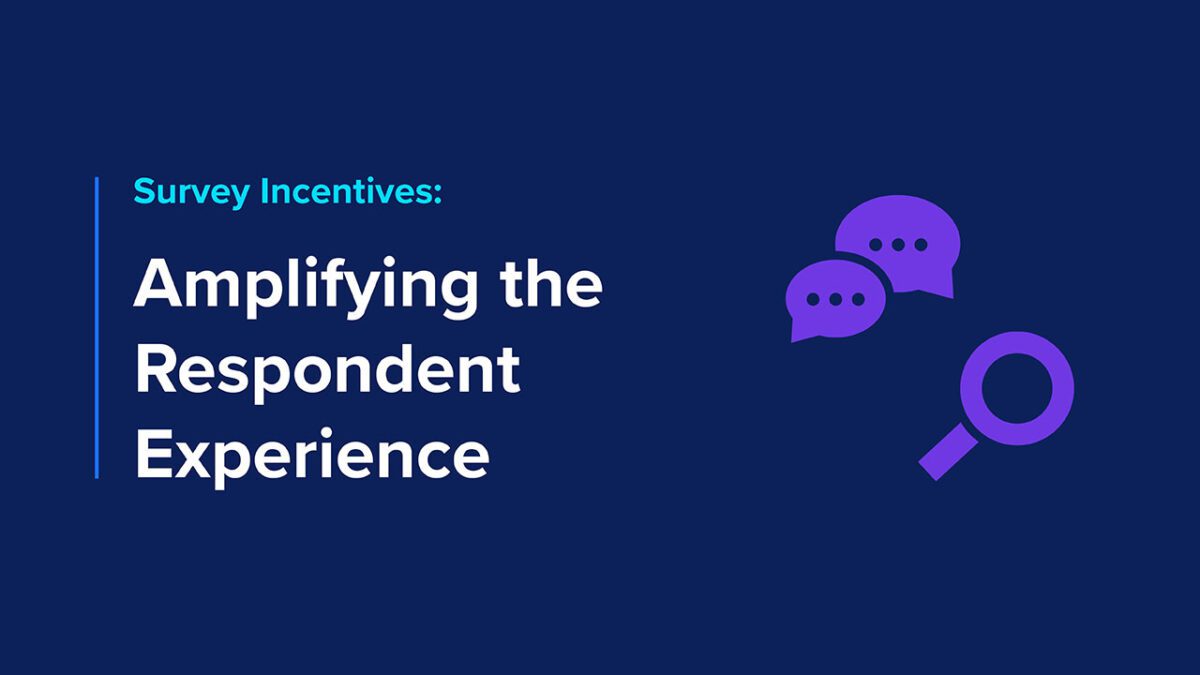Survey incentives and engagement are key to the overall research experience because respondents are the lifeblood of the insights industry. Market research would be impossible without engaged respondents willing to provide high-quality responses. However, keeping respondents motivated over the long term remains an ongoing challenge.
At the ESOMAR Congress 2023 in Amsterdam, our Chief Revenue Officer, Nate Shelley-Reade, our Director of Business Development, Danny Farkas, and Alexandrine de Montera, Chief Product Officer at Full Circle Research sat down with Iliya Hull, Senior Marketing and Community Coordinator at Esomar, Xabier Palacio, Senior Manager Intelligence Unit at Esomar, and Claudio Gennaro, Legal and Public Affairs Manager at Esomar. They discussed tactics for better engaging and incentivizing respondents.
This recap will cover:
- The Declining Motivation of Respondents
- Improving Engagement Through Experience
- Experience Issues in Survey Design
- Motivating Engagement Through Survey Incentives
- Tailoring Rewards Through Choice
- Building Trust Through Reliability
- The Power of Survey Incentives Redemption
- Balancing Engagement Optimization and Fraud Prevention
- Preventing Engagement Pitfalls
- Looking Ahead
Prefer audio? Listen to the conversation.
The Declining Motivation of Respondents
Full Circle’s Chief Product Officer Alexandrine de Montera explained that researchers analyze data daily, yet often pay little attention to the respondents providing that data or their actual survey experience. After years of discussion, respondent motivation continues declining across the industry to concerning levels.
Industry associations have initiated programs, like the Global Data Quality Initiative, to push for better treatment of respondents through improved survey design and experience. As Alexandrine noted, “If [researchers] don’t [improve treatment of respondents], at some point, it’s going to be extremely difficult to have panelists join panels and complete surveys, which is going to be a major issue for this industry.”
Improving Engagement Through Experience
An unengaged respondent does not necessarily commit fraud, but a lack of attention still leads to poor-quality data. Inserting obvious “trap” questions may frustrate engaged respondents, even while catching some inattentive ones.
Ultimately, an unpleasant or overly taxing survey experience causes frustration for respondents, potentially prompting poor quality or even fraudulent responses. As Alexandrine explained, “bad quality design that survey experience leads to bad quality responses.” Fixing engagement issues requires balancing experience and survey incentives.
Experience Issues in Survey Design
Common survey design issues negatively impacting engagement include:
- Excessive length
- Poorly structured or repetitive questions
- Re-asking unchanging questions like gender or age
- Long grid questions with massive choice lists
As Alexandrine noted, most researchers never take their own surveys. Simply reviewing their survey design from a respondent perspective would expose many of these experience pitfalls.
Initiatives like the Global Data Quality Initiative aim to promote survey design best practices addressing these issues industry-wide. However, improving the general experience only addresses part of the issue without also better incentivizing engagement.
Motivating Engagement Through Survey Incentives
Researcher preferences aside, survey incentives drive most respondents’ motivation. Nate Shelley-Reade explained that over half of research participants engage primarily for the reward.
How can we do research to understand what different kinds of audiences want as survey incentives while making sure that we’re delivering something that feels meaningful and special?
Previously “disengaging” incentive processes with unclear rewards or excessive delays left respondents feeling bait-and-switched. Simply avoiding frustration represents the basics. The advanced approach tailors meaningful, preferred rewards to attract respondents.
There’s a difference in the return on investment of respondents if they have an engaging experience, which leads them to come back and participate more than once or more than twice. In terms of lifetime value, that return on investment is relatively high, noted Nate.
Tailoring Rewards Through Choice
Respondent motivations differ tremendously across age, gender, income, and other attributes. Effective incentive programs require choosing between cash, gift cards, merchandise, donations, etc., to cater to diverse preferences.
Virtual Incentives crunches data on generational differences in reward preferences. For example, Gen Z prefers digital rewards like Venmo or Reloadable Visa over Amazon at triple the rates of other generations. Millennials also strongly prefer Visa options by 50% or more.
Understanding and accounting for cultural differences also proves vital for broad respondent engagement. The key lies in researching to understand varying needs and priorities across respondent groups.
Building Trust Through Reliability
Beyond reward preferences, following through reliably also builds crucial trust and motivation. New panelists lack familiarity and may doubt promised incentives. Not to mention, failed deliveries after redeeming points leave respondents feeling cheated and frustrated.
Keeping the redemption process instant, seamless, and reliable avoids breaking trust. Without that assurance of follow-through, panelists rarely return after a single poor experience.
The Power of Survey Incentives Redemption
Earning incentives for survey attempts motivates intrinsically. Actually redeeming those points makes benefits concrete while powerfully driving engagement.
Director of Business Development Danny Farkas mentioned the importance of engagement around your options. Common questions that are asked include:
“What options do you have? What is the user experience like? Can I customize it?”
Danny noted a direct connection to engagement, the connection between these options, and the total lifetime of a panelist.
Alexandrine mentioned that there is typically an initial trust issue because the panelist doesn’t know if they’ll get their incentive. She noted it was important for the redemption flow to be seamless and instant.
The team at Full Circle Research noticed that people who redeem rewards from survey panels tend to stick around longer and participate more compared to those who don’t redeem. If someone redeems multiple times, that’s even better – they take more surveys and stay on panels longer on average than single or non-redeemers.
It makes sense when you think about it. By offering rewards we motivate people to take surveys. So if they actually redeem those rewards, it re-engages them to want to earn more. It’s like a positive reinforcement cycle – we reward them, so they participate more, which allows us to reward them more.
The more they redeem, the more surveys they complete.
In short, cashing out encourages taking more surveys to earn more points to cash out again and creates a positive cycle benefitting both respondents and research panels.
Balancing Engagement Optimization and Fraud Prevention
Fraud unfortunately happens, so there are a lot of security checks from the first click on the recruitment banner to ensuring the individuals recruited are in the country they need to be in, the correct age, and they’re using valid emails, phone numbers, and addresses. Even with all those checks, bots and fraudsters can still get through. And then we have unengaged respondents who may not be paying attention.
Poorly tuned survey incentives also invite fraud. Setting redemption thresholds too low lets scammers cash out instantly. On the other hand, overly high redemption thresholds frustrate, demotivate, and lose legitimate panelists.
Reasonable redemption timeframes vary based on the company. According to Alexandrine, the ideal threshold facilitates redeeming within 1-3 months. This timeframe prevents fraud while keeping respondents meaningfully engaged and panels economically viable.
It’s all a matter of finding the right balance to minimize the risk of fraud and maximize panel engagement.
Challenging Demographics
Nate noted the challenges with engaging Gen Z with incentives and how there is so much more competition for Gen Z’s time and attention. This competition is particularly evident with side hustle culture and multiple ways to make additional money on nights, weekends, and free time.
He noted it might be harder to have repeat respondents in that generation. This sparks an opportunity to be innovative and convenient. Perhaps they don’t want just a Visa, but maybe a Reloadable Visa works best so that there’s more instant gratification, more cash, and more direct. Or even the option to have their incentive sent via Venmo versus PayPal.
More on the power of instant gratification.
Virtual Incentives aims to tailor what they deliver for each audience group. Overall, it’s essential to recognize what is important from a multicultural, household income standpoint, etc., as well as the different values and preferences so that they can meet them.
Preventing Engagement Pitfalls
The above balancing act never proves foolproof. Unavoidably, some legitimate respondents still slip through the cracks, growing frustrated enough to criticize their panel experience online openly.
Since even a few negative incidents seriously damage panel trust and reputation, proactively optimizing engagement remains critical.
Looking Ahead
As Nate summarized, improving respondent experience and survey incentives to boost engagement while identifying quality issues remains Virtual Incentives’ core focus for adding value.
Better segmentation and tailoring rewards by attributes like culture, income level, and generation appear vital for the path ahead. As multicultural consumers, Gen Z, and other emerging segments change behavior and preferences, researching their needs and priorities will grow more crucial over time.


